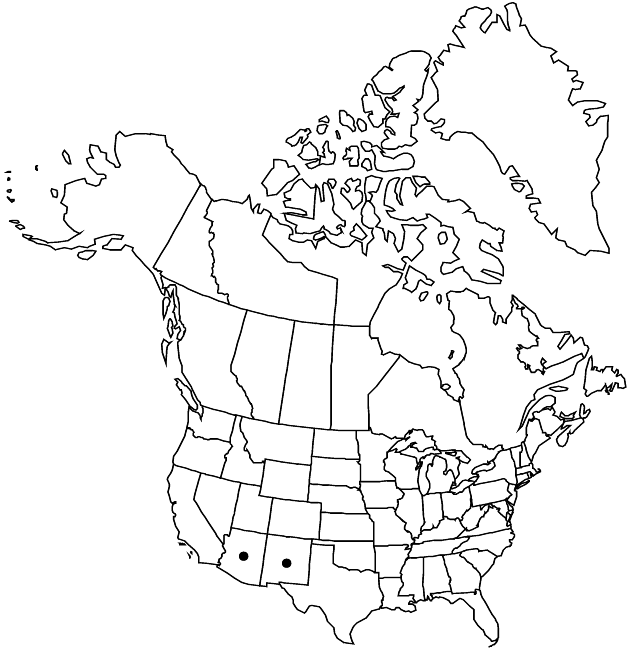Difference between revisions of "Tetraneuris argentea"
Pittonia 3: 269. 1898.
FNA>Volume Importer |
imported>Volume Importer |
||
| (5 intermediate revisions by 2 users not shown) | |||
| Line 7: | Line 7: | ||
|year=1898 | |year=1898 | ||
}} | }} | ||
| − | |basionyms={{Treatment/ID/ | + | |special_status={{Treatment/ID/Special_status |
| + | |code=E | ||
| + | |label=Endemic | ||
| + | }} | ||
| + | |basionyms={{Treatment/ID/Basionym | ||
|name=Actinella argentea | |name=Actinella argentea | ||
|authority=A. Gray | |authority=A. Gray | ||
| + | |rank=species | ||
| + | |publication_title=Mem. Amer. Acad. Arts, n. s. | ||
| + | |publication_place=4: 100. 1849 | ||
}} | }} | ||
|synonyms={{Treatment/ID/Synonym | |synonyms={{Treatment/ID/Synonym | ||
|name=Hymenoxys argentea | |name=Hymenoxys argentea | ||
|authority=(A. Gray) K. F. Parker | |authority=(A. Gray) K. F. Parker | ||
| + | |rank=species | ||
}} {{Treatment/ID/Synonym | }} {{Treatment/ID/Synonym | ||
|name=Tetraneuris formosa | |name=Tetraneuris formosa | ||
|authority=Greene ex Wooton & Standley | |authority=Greene ex Wooton & Standley | ||
| + | |rank=species | ||
}} {{Treatment/ID/Synonym | }} {{Treatment/ID/Synonym | ||
|name=Tetraneuris leptoclada | |name=Tetraneuris leptoclada | ||
|authority=(A. Gray) Greene | |authority=(A. Gray) Greene | ||
| + | |rank=species | ||
}} {{Treatment/ID/Synonym | }} {{Treatment/ID/Synonym | ||
|name=Tetraneuris trinervata | |name=Tetraneuris trinervata | ||
|authority=Greene | |authority=Greene | ||
| + | |rank=species | ||
}} | }} | ||
|hierarchy=Asteraceae;Asteraceae tribe Heliantheae;Asteraceae (tribe Heliantheae) subtribe Gaillardiinae;Tetraneuris;Tetraneuris argentea | |hierarchy=Asteraceae;Asteraceae tribe Heliantheae;Asteraceae (tribe Heliantheae) subtribe Gaillardiinae;Tetraneuris;Tetraneuris argentea | ||
| Line 46: | Line 57: | ||
-->{{#Taxon: | -->{{#Taxon: | ||
name=Tetraneuris argentea | name=Tetraneuris argentea | ||
| − | |||
|authority=(A. Gray) Greene | |authority=(A. Gray) Greene | ||
|rank=species | |rank=species | ||
| Line 60: | Line 70: | ||
|publication title=Pittonia | |publication title=Pittonia | ||
|publication year=1898 | |publication year=1898 | ||
| − | |special status= | + | |special status=Endemic |
| − | |source xml=https:// | + | |source xml=https://bitbucket.org/aafc-mbb/fna-data-curation/src/2e0870ddd59836b60bcf96646a41e87ea5a5943a/coarse_grained_fna_xml/V19-20-21/V21_1128.xml |
|tribe=Asteraceae tribe Heliantheae | |tribe=Asteraceae tribe Heliantheae | ||
|subtribe=Asteraceae (tribe Heliantheae) subtribe Gaillardiinae | |subtribe=Asteraceae (tribe Heliantheae) subtribe Gaillardiinae | ||
Latest revision as of 20:08, 5 November 2020
Perennials, 6–25(–42+) cm. Caudices ± branched, branches notably thickened distally. Stems 1–8(–12), erect, leafy, ± branched distally. Leaves basal and cauline, entire, usually densely strigoso-canescent, ± gland-dotted; basal leaves tightly clustered, blades spatulate to oblanceolate; proximal cauline blades oblanceolate; mid blades oblanceolate to linear-oblanceolate, 2.5–5 mm wide; distal blades linear-lanceolate to linear. Heads 1–10(–30) per plant (1–7 per stem), borne singly or in paniculiform to corymbiform arrays. Peduncles 2–13.5 cm, usually densely hairy. Involucres (5–)7–10 × 8–15 mm. Outer phyllaries 8–11, 4–6.5 mm, margins 0–0.3 mm wide, usually scarious, abaxial faces densely hairy. Ray florets 8–14; corollas 11.8–17 mm. Disc florets 25–75(–100+); corollas yellow proximally, yellow or rarely purplish distally, 2.8–3.8 mm. Cypselae 2.4–3.1 mm; pappi of 5–6 obovate, aristate scales 2.1–3.5 mm. 2n = 30, 60.
Phenology: Flowering (Apr–)May–Aug(–Sep).
Habitat: Roadsides, hillsides, open treeless areas, edges of woods
Elevation: (1500–)2000–2400(–3000) m
Discussion
Selected References
None.
